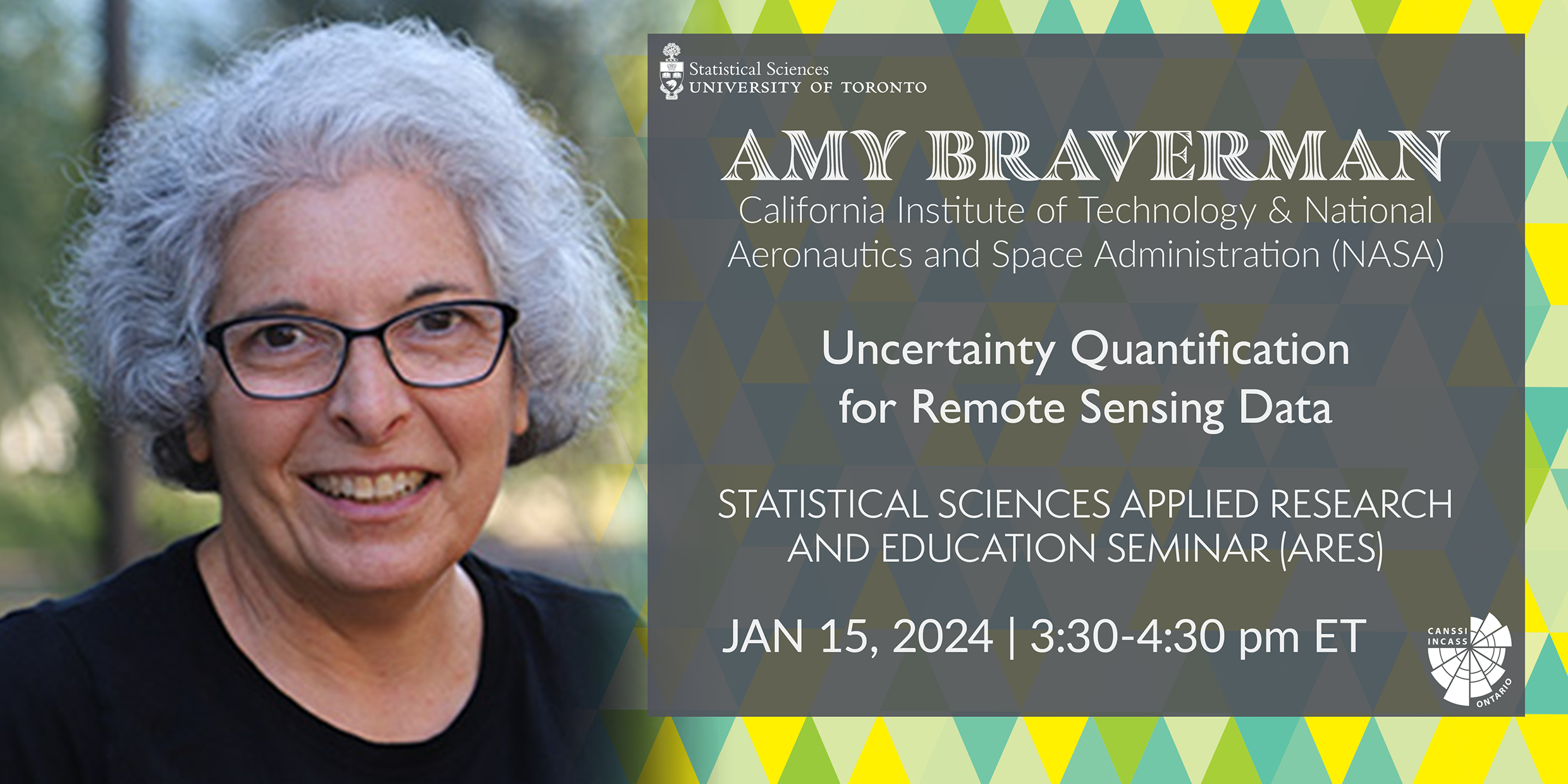- Location
- Rooms 9014 & 9016, U of T 9th Floor, 700 University Avenue, Toronto, ON M5G 1Z5
- Series/Type
- Faculty/Staff Event, Future Student Events, Seminar, Student Event, U of T Community Event
- Format
- Hybrid
- Dates
- January 15, 2024 from 3:30pm to 4:30pm
Links
Join us at the Statistical Sciences Applied Research and Education Seminar (ARES) with
Amy Braverman
Senior Research Scientist
Jet Propulsion Laboratory, California Institute of Technology
& National Aeronautics and Space Administration (NASA)
Uncertainty Quantification and Statistical Analysis Group
Free Hybrid (In-person/Online) Event | Registration Required
Talk Title
Uncertainty Quantification for Remote Sensing Data
Abstract
Remote sensing data sets produced by NASA and other space agencies are a vast resource for the study of climate change and the physical processes which drive it. However, no remote sensing instrument actually observes these processes directly; the instruments collect electromagnetic spectra aggregated over two-dimensional ground footprints or three-dimensional voxels, or sometimes just at a single point location. Inference on physical state based on these spectra occurs via a complex ground data processing infrastructure featuring a retrieval algorithm (so named because it retrieves latent true states from spectra) which typically provides point estimates and accompanying uncertainty or quality information. The method and the rigour by which uncertainties are derived varies by mission, and a key challenge is keeping up with the volume of data that needs to be processed. In fact,
uncertainties on remote sensing data products are not usually based on a standard, rigorous probabilistic framework.
In this talk, I will discuss our approach to uncertainty quantification for remote sensing data products for two NASA missions: the Orbiting Carbon Observatory 2 launched in 2014, and the new Surface Biology and Geology (SBG) mission slated for launch at the end of this decade. We rely on synthetic but realistic ensembles of true state vectors and their corresponding operationally-produced retrieval estimates, to learn conditional probability distributions of true states given their estimates via Gaussian mixture regression. That relationship is then applied to actual retrieved estimates to yield potentially non-Gaussian distributions of true states conditioned on their estimated values. I will present our methodology, and some result for OCO-2, and close by discussing our plans for SBG, which will provide orders-of-magnitude more data.
Speaker Profile
Dr. Amy Braverman is a Senior Research Scientist at the Jet Propulsion Laboratory in Pasadena, CA. She holds a Ph.D. in Statistics from UCLA, and came to JPL as a post-doctoral scholar in 1999. Prior to graduate school, she was a Research Director at Micronomics, Inc. in Los Angeles where she led teams preparing exhibits for complex civil litigation. Dr. Braverman worked on various NASA missions in various capacities over her 23 years at the Lab, first in designing data reduction methods for massive remote sensing data sets, and later expanding to address general statistical methodology and applications issues related to remote sensing. In 2012 she began working intensely on uncertainty quantification (UQ), and has developed practical methods for UQ in high-throughput, operational inverse problems of interest to NASA and JPL. She is now serving as the Chair of the SIAM Activity Group on Uncertainty Quantification, aiming to bridge the gap between traditional math-based UQ and statistics. Dr. Braverman is the recipient of NASA Exceptional Public Service Medal for her efforts to bring rigorous UQ to the NASA science enterprise. She especially enjoys working with post-docs, graduate students, and academic colleagues to bring new statistical research problems to their attention, and to work with them to implement their solutions.
